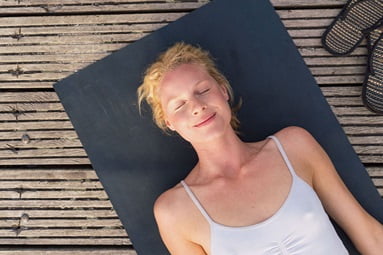
Greater satisfaction through gratitude
Practising gratitude is an easy and fun way to do something that's good for you and to reduce stress. Devoting just ten minutes a day to this habit can improve your mental and physical health and make you more content.
18.09.2025 | 2 minutes reading time

Author:
Content-Team SWICA
Content-Team SWICA
We've been programmed by evolution to be more sensitive to bad experiences and to remember them better. It was vital for our ancestors to recognise and remember potentially negative and dangerous situations, such as a predator stalking them, whereas non-threatening and pleasant experiences demanded less attention because they weren't a matter of life or death. That's why negative experiences still have a far greater impact on us, even today. But it's important to consciously acknowledge good experiences and emotions too, so that you can reduce stress. Through regular practice, it's possible to create more space for positive emotions and increase your sense of wellbeing.
There is a very simple exercise you can do to bring more gratitude into your everyday life. The idea of a gratitude diary is to consciously reflect on positive moments and "train" the brain to intentionally register positive impressions more effectively in future.
There is a very simple exercise you can do to bring more gratitude into your everyday life. The idea of a gratitude diary is to consciously reflect on positive moments and "train" the brain to intentionally register positive impressions more effectively in future.
How can we practise gratitude?
1. Set a fixed time. The easiest way to make practising gratitude part of your daily routine is to pick a specific time of day to do it. This could be when you wake up in the morning, in the evening before going to sleep or when you have a quiet moment in your day.
2. Note down three good things. Start by thinking back over the previous day. What good things happened? How did you feel at the time? What are you grateful for? Describe your experiences in as much detail as you can to maximise the effectiveness of the exercise. It may help to use as many descriptive words as possible, or to put names to different feelings. This helps transport you back to the moment when you felt grateful, and activates positive emotions. The three things could be small pleasures or major events – the main thing is that you associate them with a positive feeling. To help get you started, you could use the following template with examples.
And if you can't think of three things straight away, don't worry. That's completely normal. It gets easier with time. The positive effect that practising gratitude exercises has on our health is scientifically proven. Studies have shown that a gratitude diary can help to improve your mood, sleep and heart health.
3. Boost your self-esteem: How did I contribute towards making these three things happen?
4. Repeat the exercise every day for at least two weeks in order to improve your wellbeing and your health.
3. Boost your self-esteem: How did I contribute towards making these three things happen?
4. Repeat the exercise every day for at least two weeks in order to improve your wellbeing and your health.
Learn more about gratitude and your health here:
For your health: santé24 and SWICA Benecura
Do you have a health question? Our physicians and healthcare professionals at santé24 are available 24/7 on +41 44 404 86 86 for SWICA customers. In addition to telephone health advice, patients whose conditions are appropriate for telemedicine can receive medical services such as diagnostics, treatment, and even e-prescriptions for prescription medications.
Do you feel ill? The SWICA Benecura medical app makes it easy to carry out a digital SymptomCheck. You will receive a personal recommendation about what to do next. Send your information in encrypted form to the santé24 online practice for your telephone consultation to significantly shorten the assessment.







